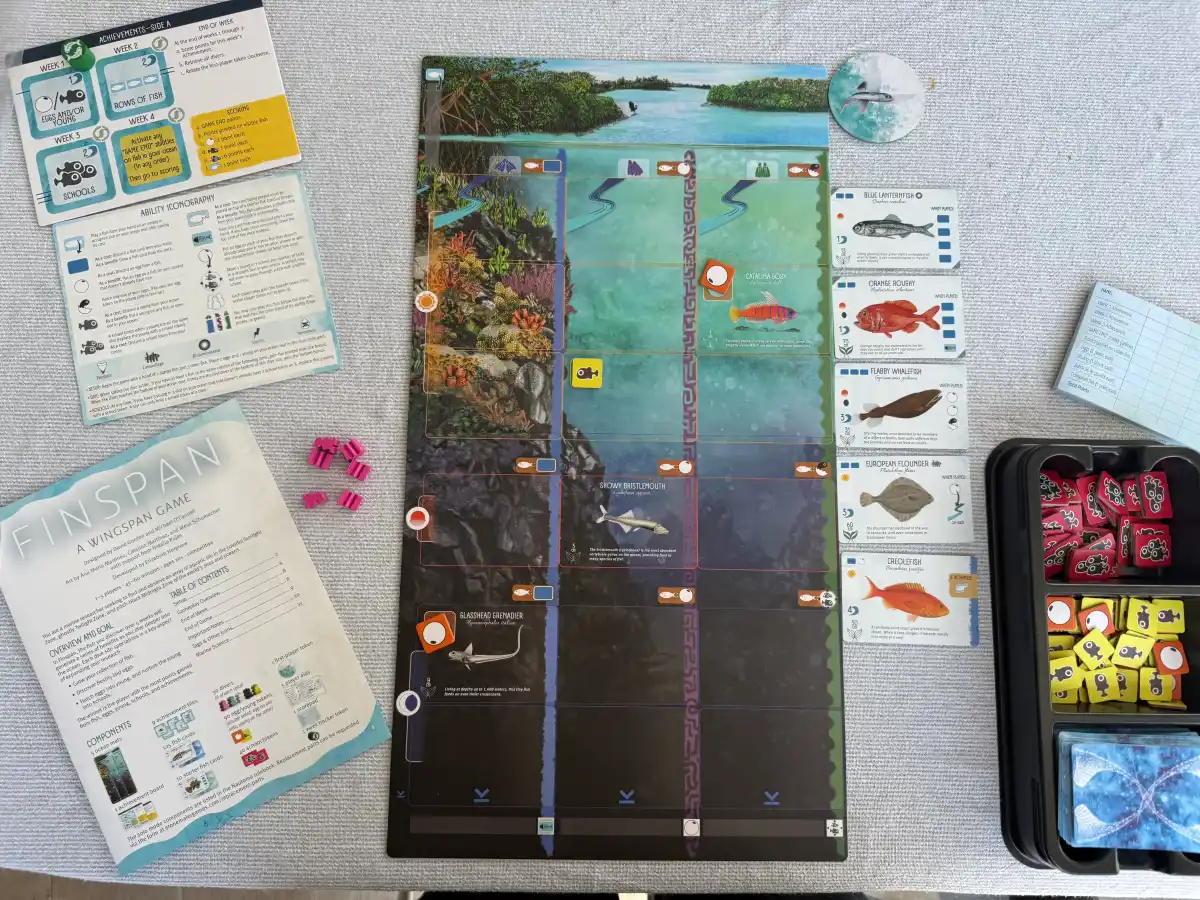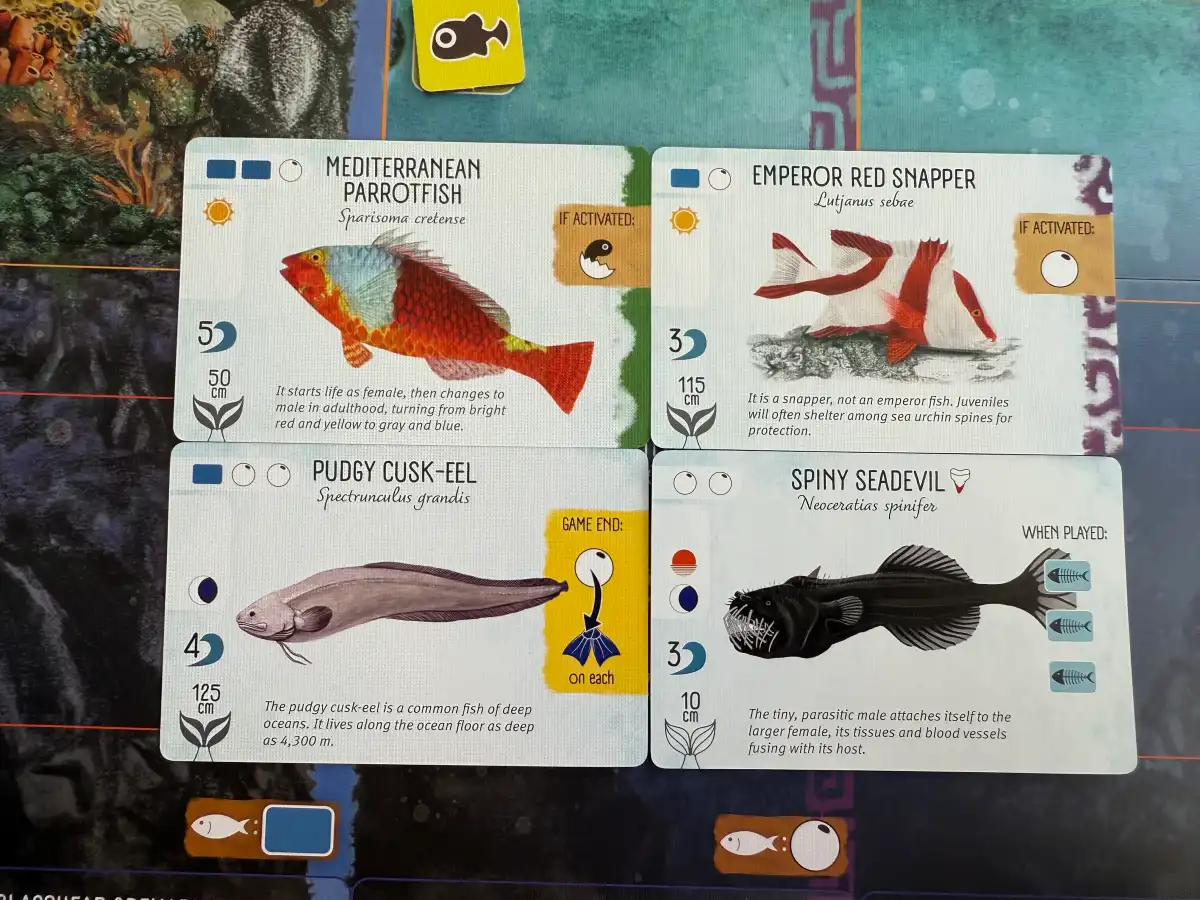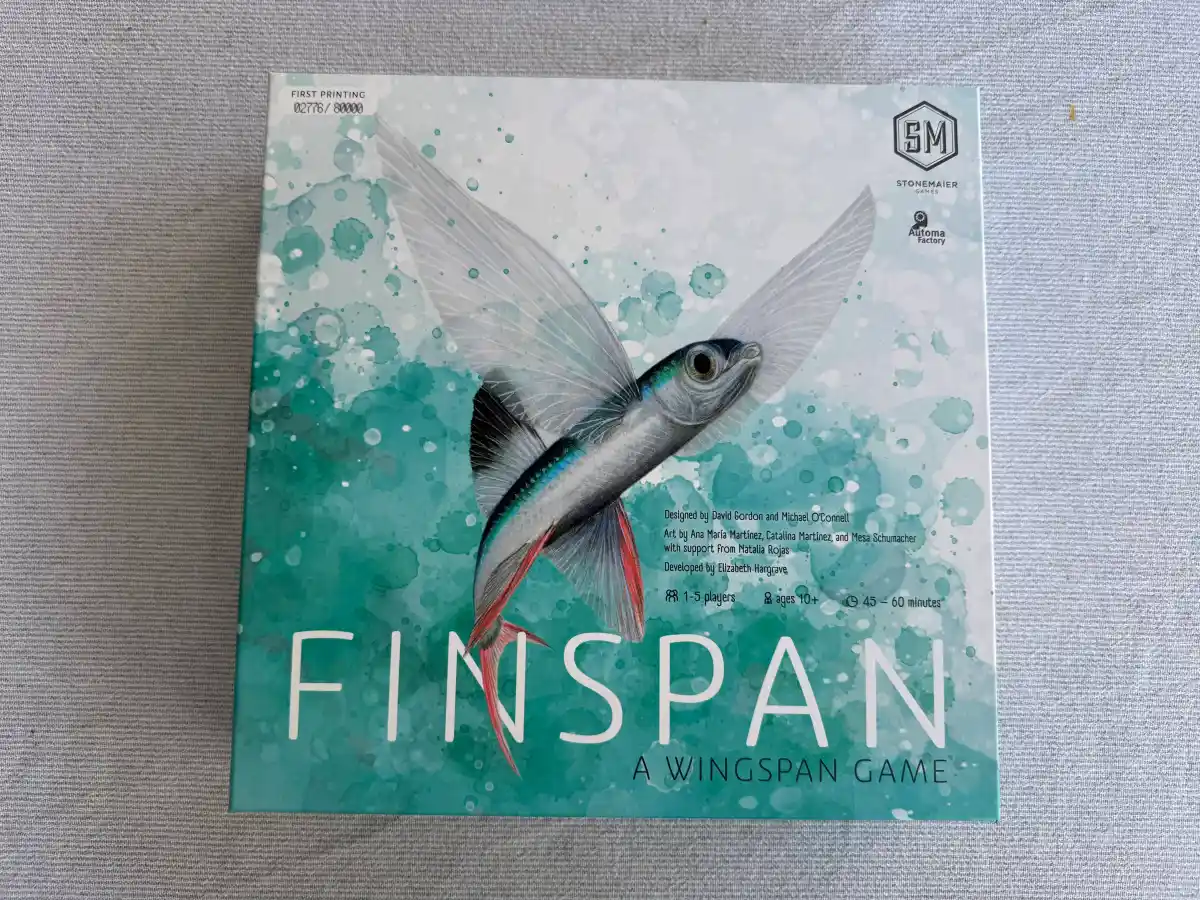Wingspan has become one of those classic gateway board games, despite only being released in 2019. Gorgeous art, whimsical touches (like cute eggs, and a little bird house dice tower), and really satisfying gameplay mechanics that allow for a lot of replay, quickly shot it to instant classic status.
Finspan is the third game in the series, and as the name suggests, it is fish themed. I’ve now played a few games of it, and there is so much to love here – though there are a few things that I think will hold it back from reaching the same cult status as Wingspan.
Finspan is a medium-lightweight board game that takes around 45 minutes to play, is suitable for 1-5 players and has heaps of replay value. I thought the pace worked better with two players, but with the right group it’s excellent with more people.
Read: 27 big upcoming board games releasing in 2025

What’s in the box?
In the box there are five game boards, 152 cards (including Automa, starter and regular fish cards), 30 wooden diver tokens, 90 egg/young cardboard tokens, 40 cardboard school tokens, 9 achievement tiles, 5 player aids, a score pad, a week tracker token, a first-player token, and a token caddy with three dividers and a lid.
There are a few things that are immediately noticeable about the contents. The first is that, as expected, the fish cards are beautifully illustrated. The artists did an excellent job. I also really love the facts about each fish on the cards, some of them are delightful, some are absolutely brutal, and all of them really add to the vibe of the game.
It makes it clear that everyone involved in making the game were passionate about these fish, which in turn makes the player feel slightly more attached to them. It makes it easier to find favourites beyond their abilities. They feel like characters, rather than tools.
The second is that there is a distinct lack of adorable pieces. It wasn’t just the art and the gameplay of wingspan that made it a classic, but the extra little touches that made the game feel special. The bird house and those little eggs were important.
You can buy a Finspan upgrade pack which includes egg, young and school tokens for $50 (I have already ordered one from my local game store). Not including them in the box has likely reduced the cost, which possibly means more people will probably give the game a go (Finspan retails for $79, whereas Wingspan and Wyrmspan are $100). But it does take away from the magic a little bit.
The third thing is that there is no obvious or neat way to store the cards without them going everywhere or getting them mixed up in the box. The token box isn’t tall enough to fit all the standard fish cards in the one slow, and there are three flavours of card. It’s fine, there are ways to make it work, but it is a bit clunky. There is room in the box to fit more storage, and I will 3D print some, however it would have been better if this had been considered in the design and packaging phase of development.
The Finspan premise
Finspan is all about diving to discover fish. There are three different diving zones which give you eggs, hatch your eggs, or give you more cards. In those three diving zones, there are three light zones: sunlight zone, twilight zone and midnight zone. Fish will need to be placed in the appropriate zone, and will cost what is printed on the card (as opposed to Wingspan, where the cost was dependant on how many birds had been placed beforehand).
The aim of the game is to get the most points at the end, which are gained by having eggs, young or (most of all) schools of fish which form when the player has a group of three young. Players will also gain points from end of round goals, and the fish they discover.

How does Finspan compare to the other spans, and is it good?
I am extremely familiar with Wingspan. I have played dozens of games with the physical board game, but it was also my wife’s and my comfort game during the Melbourne Covid lockdowns. According to Steam, we have played over 570 hours of the digital version. I’ve also played around half a dozen games of Wyrmspan. I say this not to brag (or as a cry for help), but to illustrate how comfortable I am with the ____span format. So, believe me when I say that I think Finspan is a better introduction to the ____span games than Wingspan.
The best way to think about Finspan is to consider a deck building game with resource management and rounds, where each round has a set number of terms and a mini-objective.
It’s a more gentle and forgiving game. There are so many turns in Wingspan where, if you get a bad hand, you just feel like you’re spinning your wheels, unable to collect many resources to get out of the hole. With Finspan, as long as you have one fish in the column you’re diving, you can always get a decent amount of resources.
Having a deck of 10 starter dish, from which each player draws two in addition to three regular fish, ensures that everyone has at least two solid fish to get them started, that they can afford to play off the bat. Not having the revealed cards to select from means that you’re drawing cards because you want cards, not because you want to stop the other player from getting a certain card. That might suck the fun out for some people, whereas for others it’ll mean a more harmonious game.
One thing that I really enjoyed in the most recent game of Finspan that I played is that all three of us were playing different strategies. One failed utterly miserably. But the separation between someone who aimed for primarily high-value fish, and someone else who focused on playing heaps of fish early and then covering them in schools was one point. There wasn’t quite the diversity of approaches that you could have in Wingspan or Wyrmspan, but there’s enough that there’s something to suit most members of your gaming group.
I maintain that the best strategy is to play as many fish as possible and then flood the board with schools, but I’m sure after the 15th or 30th time we play, that strategy will get more specific, and I’ll start hunting for specific fish. The great thing is that there’s the option of depth – you can shallowly just play fish and lay eggs, or you get get super into creating fish synergies the more familiar you get with the game.

I’d liken the approachability of Finspan compared to Wingspan, to Azul vs Azul Summer Pavillion. It’s the same basic idea, but there are more ways to get resources, and it’s less prone to sniping from other players. The focus is more on your board and less what your opponents are doing. It’s like the makers of Wingspan took feedback from two different types of players and made Wyrmspan for the more intense, and Finspan for the more chill.
My one big complaint is that the game boards are too darn long (56cm). I think my dining table is a fairly normal size – I inherited it from my great-grandmother, so there’s a chance it’s not a current standard size, but we couldn’t have two game boards end to end without a decent chunk of each of them hanging off the table.
This meant that any time one of us wanted to get up, we would lightly bump the board. There are so many other things going on in the set up, that there wasn’t a lot of spare table. This is something to consider for my fellow apartment dwellers.
Does everyone need Finspan?
Finspan is excellent. If you have a big enough table, it’s something everyone can enjoy. Especially if purchased with the upgrade pack. If you’ve never played a ‘Span game before, I think Finspan is probably the best entry point to the series. I still prefer Wingspan, but I bring my own emotional baggage to that connection.
From a pure gameplay perspective, Finspan will be the game I teach my friends to play before introducing them to Wingspan. It’s not an either/or, you should play both (and then Wyrmspan afterwards). It’s just that Finspan is more accessible, it’s a little more forgiving. It’s a must play for fans of the other games in the series, and also generally for people who like casual board games.





